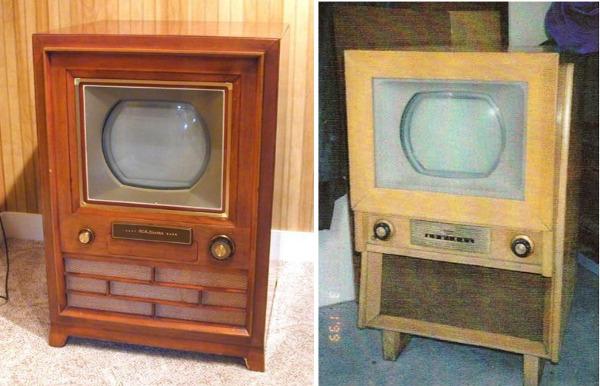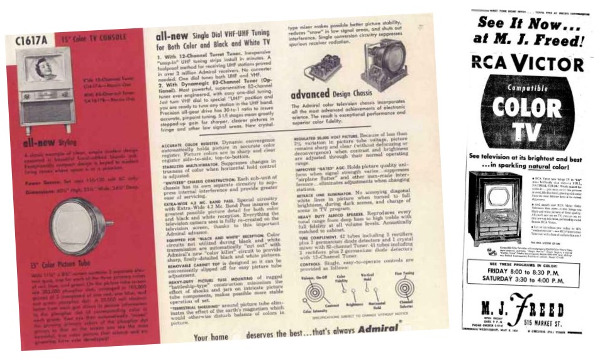65 Years Ago Today: The First Color TVs Arrive

Even though 4K TVs have been on the market for less than five years, numerous companies will announce they’ll start selling 8K TVs at CES next week. This despite the fact that less than half of U.S. homes own a 4K TV, and there’s no 4K programming available yet on U.S. broadcast TV networks.
A mite premature? That’s how it must have seemed to the public 65 years ago when, on December 30, 1953, Admiral and RCA put the first color televisions up for sale. At the time, TV itself was only a few years old, less than half of U.S. homes had a TV, and there was barely any color programming to watch and wouldn’t be for nearly a decade.
From its earliest imaginings in the late 19th and early 20th centuries, TV innovators included color in their dreams and patent applications. In 1928, Scottish inventor John Logie Baird was the first to demonstrate color TV, a mechanical system employing a Nipkow wheel, followed by a similar system from Bell Labs in 1929. But most TV development over the next 10 years centered on establishing a monochrome TV standard. In 1940, the FCC created a new body, the National Television Systems Committee (NTSC), as an objective adjudicator to approve a unified electronic TV system.
Just as TV standards were being negotiated, CBS, led by its star engineer Peter Goldmark, made the first mark in all-electronic color TV with a series of demonstrations in 1940-41. According to Susan Murray in her excellent and exhaustive recent book, Bright Signals: A History of Color TV, it was “an effort to both boost their corporate image as a technological innovator and hopefully delay the approval of the RCA-backed black and white standard for television.” But the FCC went ahead and approved the now-familiar 525-line NTSC standard in 1941. World War II then put a stop to all further TV development, black-and-white and color.
Color TV development picked up immediately after the war. CBS and NBC, along with a host of other color pretenders, refined their technologies, ran myriad field tests, and made multiple presentations to government committees. On October 11, 1950, the FCC approved the CBS system.
The CBS color standard required an ungainly color converter wheel, and it was incompatible with the existing NTSC monochrome scanning system. To overcome this incompatibility, the FCC required that TV makers produce sets capable of receiving both black-and-white and non-compatible color signals, a requirement that TV makers understandably loathed. A few days after the FCC order, RCA — the nation’s leading TV manufacturer and the owner of NBC — filed suit in federal court.
On May 28, 1951, the Supreme Court upheld the FCC’s decision. But while CBS may have won the battle, it lost the color war. During the seven-month court battle, publicity from the case made consumers aware of CBS’ system incompatibility, while RCA increased its TV market share by 50 percent and was able to refine its color system. On December 17, 1953, the FCC reversed itself and announced a new NTSC color standard — essentially, the RCA system.

Two weeks later, RCA rushed out 200 prototype 15-inch Model 5 sets to its top dealers around the country for viewing parties of the upcoming New Year’s Day Rose Bowl Parade. NBC was broadcasting the parade in living color, the first nationwide color broadcast. The Model 5, which can be seen — and watched — at the Early TV Museum in Hilliard, OH, would become the factory-produced CT-100 priced at $1,000 — around $9,500 today — when it went on sale the following spring. Admiral also started selling its 15-inch C1617A color set the same day for $1,175, around $11,000 today.
Not surprisingly, color was not nearly the hit that 4K is, or as 8K likely will be. Time magazine proclaimed color TV to be “the most resounding industrial flop of 1956.” It wasn’t until 1968 that most prime time shows on the three major networks were broadcast in color, and not until 1972 that sales of color TVs surpass those of black-and-white models.
Whether it will take 15 years for networks to broadcast shows in 4K or 8K remains to be seen.
























































